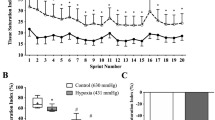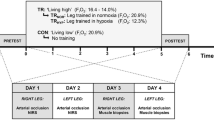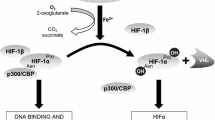Abstract
Intermittent hypoxic exposure with exercise training is based on the assumption that brief exposure to hypoxia is sufficient to induce beneficial muscular adaptations mediated via hypoxia-inducible transcription factors (HIF). We previously demonstrated (Mounier et al. Med Sci Sports Exerc 38:1410–1417, 2006) that leukocytes respond to hypoxia with a marked inter-individual variability in HIF-1α mRNA. This study compared the effects of 3 weeks of intermittent hypoxic training on hif gene expression in both skeletal muscle and leukocytes. Male endurance athletes (n = 19) were divided into an Intermittent Hypoxic Exposure group (IHE) and a Normoxic Training group (NT) with each group following a similar 3-week exercise training program. After training, the amount of HIF-1α mRNA in muscle decreased only in IHE group (−24.7%, P < 0.05) whereas it remained unchanged in leukocytes in both groups. The levels of vEGF121 and vEGF165 mRNA in skeletal muscle increased significantly after training only in the NT group (+82.5%, P < 0.05 for vEGF121; +41.2%, P < 0.05 for vEGF165). In leukocytes, only the IHE group showed a significant change in vEGF165 (−28.2%, P < 0.05). The significant decrease in HIF-1α mRNA in skeletal muscle after hypoxic training suggests that transcriptional and post-transcriptional regulations of the hif-1α gene are different in muscle and leukocytes.



Similar content being viewed by others
References
Ameln H, Gustafsson T, Sundberg CJ, Okamoto K, Jansson E, Poellinger L, Makino Y (2005) Physiological activation of hypoxia inducible factor-1 in human skeletal muscle. FASEB J 19:1009–1011
Brown HR, Ni H, Benavides G, Yoon L, Hyder K, Giridhar J, Gardner G, Tyler RD, Morgan KT (2002) Correlation of simultaneous differential gene expression in the blood and heart with known mechanisms of adriamycin-induced cardiomyopathy in the rat. Toxicol Pathol 30:452–469
Cayre A, Rossignol F, Clottes E, Penault-Llorca F (2003) aHIF but not HIF-1alpha transcript is a poor prognostic marker in human breast cancer. Breast Cancer Res 5:223–230. doi:10.1186/bcr652
Clark SA, Aughey RJ, Gore CJ, Hahn AG, Towsend NE, Kinsman TA, Chow CM, Mc Kenna MJ, Hawley JA (2004) Effects of live high, train low hypoxic exposure on lactate metabolism in trained humans. J Appl Physiol 96:517–525. doi:10.1152/japplphysiol.00799.2003
Däpp C, Gassmann M, Hoppeler H, Flück M (2006) Hypoxia-induced gene activity in disused oxidative muscle. Adv Exp Med Biol 588:171–188. doi:10.1007/978-0-387-34817-9_16
Elder GC, Bradbury K, Roberts R (1982) Variability of fiber type distributions within human muscles. J Appl Physiol 53:1473–1480
Flück M, Däpp C, Schmutz S, Wit E, Hoppeler H (2005) Transcriptional profiling of tissue plasticity: role of shifts in gene expression and technical limitations. J Appl Physiol 99:397–413. doi:10.1152/japplphysiol.00050.2005
Forsythe JA, Jiang BH, Iyer NV, Agani F, Leung SW, Koos RD, Semenza GL (1996) Activation of vascular endothelial growth factor gene transcription by hypoxia-inducible factor 1. Mol Cell Biol 16:4604–4613
Friedmann B, Kinscherf R, Borisch S, Richter G, Bartsch P, Billeter R (2003) Effects of low-resistance/high-repetition strength training in hypoxia on muscle structure and gene expression. Pflugers Arch 446:742–751. doi:10.1007/s00424-003-1133-9
Gustafsson T, Puntschart A, Kaijser L, Jansson E, Sundberg CJ (1999) Exercise-induced expression of angiogenesis-related transcription and growth factors in human skeletal muscle. Am J Physiol 276:679–685
Gustafsson T, Knutsson A, Puntschart A, Kaijser L, Nordqvist AC, Sundberg CJ, Jansson E (2002) Increased expression of vascular endothelial growth factor in human skeletal muscle in response to short-term one-legged exercise training. Pflugers Arch 444:752–759. doi:10.1007/s00424-002-0845-6
Ishihara A, Itoh K, Itoh M, Hirofuji C, Hayashi H (1994) Hypobaric-hypoxic exposure and histochemical responses of soleus muscles fibers in the rat. Acta Histochem 96:74–80
Itoh K, Itoh M, Ishihara A, Hirofuji C, Hayashi H (1995) Influence of 12 weeks of hypobaric hypoxia on fibre type composition of the rat soleus muscle. Acta Physiol Scand 154:417–418
Jewell UR, Kvietikova I, Scheid A, Bauer C, Wenger RH, Gassmann M (2001) Induction of HIF-1alpha in response to hypoxia is instantaneous. FASEB J 15:1312–1314
Juel C, Lundby C, Sander M, Calbet JAL, van Hall G (2003) Human skeletal muscle and erythrocyte proteins involved in acid-base homeostasis: adaptations to chronic hypoxia. J Physiol 548:639–648. doi:10.1113/jphysiol.2002.035899
Kraniou Y, Cameron-Smith D, Misso M, Collier G, Hargreaves M (2000) Effects of exercise on GLUT-4 and glycogenin gene expression in human skeletal muscle. J Appl Physiol 88:794–796. doi:10.1063/1.373804
Mason SD, Howlett RA, Kim MJ, Olfert IM, Hogan MC, McNulty W, Hickey RP, Wagner PD, Kahn CR, Giordano FJ, Johnson RS (2004) Loss of skeletal muscle HIF-1alpha results in altered exercise endurance. PLoS Biol 10:e288. doi:10.1371/journal.pbio.0020288
McLelland GB, Brooks GA (2002) Changes in MCT1, MCT4 and LDH expression are tissue specific in rats after long-time hypobaric hypoxia. J Appl Physiol 92:1573–1584
Mounier R, Pialoux V, Cayre A, Schmitt L, Richalet JP, Robach P, Lasne F, Coudert J, Fellmann N, Clottes E (2006) Leukocyte’s HIF-1 expression and training-induced erythropoietic response in swimmers. Med Sci Sports Exerc 38:1410–1417. doi:10.1249/01.mss.0000228955.98215.a1
Newlands S, Levitt LK, Robinson CS, Karpf AB, Hodgson VR, Wade RP, Hardeman EC (1998) Transcription occurs in pulses in muscle fibers. Genes Dev 1:2748–2758. doi:10.1101/gad.12.17.2748
Ookawara T, Suzuk K, Haga S, Ha S, Chung KS, Toshinai K, Hamaoka T, Katsumura T, Takemasa T, Mizuno M, Hitomi Y, Kizaki T, Suzuki K, Ohno H (2002) Transcription regulation of gene expression in human skeletal muscle in response to endurance training. Res Commun Mol Pathol Pharmacol 111:41–54
Pette D (1985) Metabolic heterogeneity of muscle fibres. J Exp Biol 115:179–189
Peuker H, Pette D (1997) Quantitative analyses of myosin heavy-chain mRNA and protein isoforms in single fibers reveal a pronounced fiber heterogeneity in normal rabbit muscles. Eur J Biochem 1:30–36. doi:10.1111/j.1432-1033.1997.00030.x
Plomgaard P, Penkowa M, Pedersen BK (2005) Fiber type specific expression of TNF-alpha, IL-6 and IL-18 in human skeletal muscles. Exerc Immunol Rev 11:53–63
Plomgaard P, Penkowa M, Leick L, Pedersen BK, Saltin B, Pilegaard H (2006) The mRNA expression profile of metabolic genes relative to MHC isoform pattern in human skeletal muscles. J Appl Physiol 101:817–825. doi:10.1152/japplphysiol.00183.2006
Ponsot E, Dufour SP, Zoll J, Doutrelau S, N’Guessan B, Geny B, Hoppeler H, Lampert E, Mettauer B, Ventura-Clapier R, Richard R (2006) Exercise training in normobaric hypoxia in endurance runners II Improvement of mitochondrial properties in skeletal muscle. J Appl Physiol 100:1249–1257. doi:10.1152/japplphysiol.00361.2005
Prior SJ, Hagberg JM, Paton CM, Douglass LW, Brown MD, McLenithan JC, Roth SM (2006) DNA sequence variation in the promoter region of the VEGF gene impacts VEGF gene expression and maximal oxygen consumption. Am J Physiol Heart Circ Physiol 290:1848–1855. doi:10.1152/ajpheart.01033.2005
Puntschart A, Wey E, Jostarndt K, Vogt M, Wittwer M, Widmer HR, Hoppeler H, Billeter R (1998) Expression of fos and jun genes in human skeletal muscle after exercise. Am J Physiol 274:129–137
Roels B, Bentley DJ, Coste O, Mercier J, Millet GP (2007a) Effects of intermittent hypoxic training on cycling performance in well-trained athletes. Eur J Appl Physiol 101:359–368. doi:10.1007/s00421-007-0506-8
Roels B, Thomas C, Bentley DJ, Mercier J, Hayot M, Millet G (2007b) Effects of intermittent hypoxic training on amino and fatty acid oxidative combustion in human permeabilized muscle fibers. J Appl Physiol 102:79–86. doi:10.1152/japplphysiol.01319.2005
Rossignol F, Vaché C, Clottes E (2002) Natural antisense transcripts of hypoxia-inducible factor 1alpha are detected in different normal and tumour human tissues. Gene 299:135–140. doi:10.1016/S0378-1119(02)01049-1
Rossignol F, Solares M, Balanza E, Coudert J, Clottes E (2003) Expression of lactate dehydrogenase A and B genes in different tissues of rats adapted to chronic hypobaric hypoxia. J Cell Biochem 89:67–79. doi:10.1002/jcb.10484
Rossignol F, de Laplanche E, Mounier R, Bonnefont J, Cayre A, Godinot C, Simonnet H, Clottes E (2004) Natural antisense transcripts of HIF-1α are conserved in rodents. Gene 339:121–130. doi:10.1016/j.gene.2004.06.029
Schmutz S, Däpp C, Wittwer M, Vogt M, Hoppeler H, Flück M (2006) Endurance training modulates the muscular transcriptome response to acute exercise. Pflugers Arch 451:678–687. doi:10.1007/s00424-005-1497-0
Seiler KS, Kjerland GØ (2006) Quantifying training intensity distribution in elite endurance athletes: is there evidence for an “optimal” distribution? Scand J Med Sci Sports 16:49–56. doi:10.1111/j.1600-0838.2004.00418.x
Semenza GL (2003) Targeting HIF-1 for cancer therapy. Nat Rev Cancer 3:721–732. doi:10.1038/nrc1187
Thomas C, Sirvent P, Perrey S, Raynaud E, Mercier J (2004) Relationships between maximal muscle oxidative capacity and blood lactate removal after supramaximal exercise and fatigue indexes in humans. J Appl Physiol 97:2132–2138. doi:10.1152/japplphysiol.00387.2004
Thrash-Bingham CA, Tartof KD (1999) aHIF: a natural antisense transcript overexpressed in human renal cancer and during hypoxia. J Natl Cancer Inst 91:143–151. doi:10.1093/jnci/91.2.143
Tikkanen HO, Hämäläinen E, Härkönen M (1999) Significance of skeletal muscle properties on fitness, long-term physical training and serum lipids. Atherosclerosis 142:367–378. doi:10.1016/S0021-9150(98)00261-5
Uchida T, Rossignol F, Matthay MA, Mounier R, Couette S, Clottes E, Clerici C (2004) Prolonged hypoxia differentially regulates hypoxia-inducible factor (HIF)-1alpha and HIF-2alpha expression in lung epithelial cells: implication of natural antisense HIF-1alpha. J Biol Chem 279:14871–14878. doi:10.1074/jbc.M400461200
Vogt M, Puntschart A, Geiser J, Zuleger C, Billeter R, Hoppeler H (2001) Molecular adaptations in human skeletal muscle to endurance training under simulated hypoxic conditions. J Appl Physiol 91:173–182
Wittwer M, Billeter R, Hoppeler H, Fluck M (2004) Regulatory gene expression in skeletal muscle of highly endurance-trained humans. Acta Physiol Scand 180:217–227. doi:10.1046/j.0001-6772.2003.01242.x
Zeibig J, Karlic H, Lohninger A, Damsgaard R, Smekal G (2005) Do blood cells mimic gene expression profile alterations known to occur in muscular adaptation to endurance training? Eur J Appl Physiol 95:96–104. doi:10.1007/s00421-005-1334-3
Zoll J, Ponsot E, Dufour SP, Doutrelau S, Ventura-Clapier R, Vogt M, Hoppeler H, Richard R, Fluck M (2006) Exercise training in normobaric hypoxia in endurance runners III. Muscular adaptations of selected gene transcripts. J Appl Physiol 100:258–1266. doi:10.1152/japplphysiol.00936.2005
Acknowledgments
The authors would like to express gratitude to the athletes for their donation of time, muscle and blood. They also thank Fabrice Kwiatkowski for statistics. This study was funded by the “International Olympic Committee” and the “Ministère Français de la Jeunesse et des Sports”.
Author information
Authors and Affiliations
Corresponding author
Rights and permissions
About this article
Cite this article
Mounier, R., Pialoux, V., Roels, B. et al. Effect of intermittent hypoxic training on HIF gene expression in human skeletal muscle and leukocytes. Eur J Appl Physiol 105, 515–524 (2009). https://doi.org/10.1007/s00421-008-0928-y
Accepted:
Published:
Issue Date:
DOI: https://doi.org/10.1007/s00421-008-0928-y




